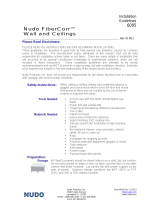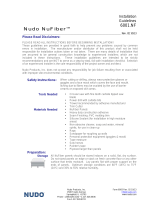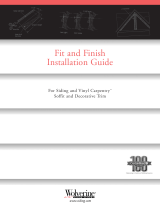Environmental Conditions: Temperature is always a factor when working with composite vinyl materials. In
warm temperature conditions, above 70°F (21°C) cool panels to a minimum of 60°F (16°C) overnight. In cold
temperature conditions, below 40°F (4°C) warm panels to a minimum of 60°F (16°) overnight. When installation
conditions of under 60° (16°) is unavoidable, insert penny between panels. When below 32°F (0°C), insert a nickel
between panels to allow spacing for expansion in hot weather. Use a silicone and adhesive recommended for low
temperatures, following the manufacturer’s application guidelines. Check with the local building codes for specific
requirements. Do NOT use Utilite panels in high temperature conditions; PVC has a heat distortion threshold in
temperatures exceeding 120° F (55°C). Please discuss with your HVAC contractor prior to install. Ceiling fans and
blowers may need to be installed, along with shielded Tube Radiant Heaters with a maintained clearance of 24" to
distribute heat uniformly throughout facility. Prolonged exposure to direct sunlight MAY CAUSE the panels to fade
and/or rapid expansion. Please use extreme caution when installing panels in these types of environments. Nudo will
not warranty any panels distorted because of excessive heat exposure due to improper installation and operation of
heaters and furnaces in areas where Utilite has been installed.
Cutting Instructions: Always use proper personal protection equipment when cutting Utilite panels. Read and
follow manufacturer's guidelines for use of cutting tools. Panels can be cut using a power miter saw with fine tooth
blade, utility knife with guiding straight edge (cutting panel 5-7 times to score and cut through panel), and table saw
with fine tooth carbide blade. DO NOT RUSH. CUT THROUGH PANELS SLOW AND STEADY. A test cut is
always recommended to see performance of cutting tool with Utilite panels.
Prior to Installation: Installation should NOT begin until building is enclosed (windows and doors installed).
Permanent heating and cooling equipment is in operation, and residual moisture from plaster, concrete, etc. is
dissipated. Prior to installation, the installer must determine that the environmental conditions meets or exceeds all
requirements specified in the installation guidelines. CEILINGS SHOULD BE INSTALLED PRIOR TO WALLS.
Before installing remove packaging materials. Allow the panels to acclimate to the room temperature and humidity
for 48 hours before installing. Acclimation temperature range should be 60° to 75°F (16°C to 24°) and relative
humidity should be 35% to 55%. Maximum temperature exposure during installation 32°-120°. Ideally, the room
temperature and humidity during acclimation and installation should be the same as the final operation conditions.
DO NOT install panels tight when cold (below 60°), panels will expand in warmer temperatures (above 70°). Allow
room for expansion contraction between each panel.
Ceiling Pre-Installation Planning: CEILING PANELS SHOULD BE INSTALLED PRIOR TO WALLS (if
possible). Take proper measurements. The panels should NOT SPAN LONGER than 24" between ceiling trusses. If
building is insulated, PRIOR TO INSTALLING PANELS, use 3mm poly sheeting to create a vapor barrier on walls
and ceilings. A 24" clearance shield should be maintained between panels and Radiant Tube Heaters and ceiling
furnaces. The panels have a 120° F (55°C) heat distortion threshold. Installing ceiling fans and blowers around
heating devices to circulate hot air throughout facility is highly recommended. It is the installer responsibility to
select the proper fasteners for the application.











